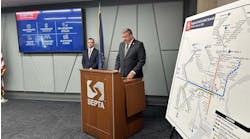Taking a data-driven approach to improve transit operations is growing among agencies. How this is accomplished varies from agency to agency, but a few common themes emerged: The need to listen to all stakeholders involved to ensure the intended outcome is the correct outcome and the ability to empower frontline employees who will perpetuate best practices resulting in long-term solutions.
Focus on process
The Washington Metropolitan Area Transit Authority’s (WMATA) Strategic Initiatives Team was established in 2017. Inspired by their namesake department in New York City Transit, the team drives strategic change in operations (rail, bus, paratransit, police and support services) to improve safety, customer service and efficiency. Its members say getting the message out about what the team can accomplish was difficult but has evolved into one of the more rewarding parts of the job.
“We arrived on individuals’ doorsteps who had 25-30 years of experience in transit. We have different ideas and a task to change the way they do business. Initial conversations were tough” explains Jayme Johnson, director of Strategic Initiatives. “But once we demonstrated to our colleagues that there are other ways of doing things, and that our team can have a positive impact on the way you do business, trust grew and we started to get a lot of traction.”
One area the team is working to improve is the challenge of track access. WMATA has a $1.75 billion capital program in Fiscal Year 2020 that will in part focus on the rebuild and repair of the rail system. But there are limited work windows available to get the work done during non-revenue hours. The team is focusing on increasing the number of hours spent working during those windows.
“As you can imagine, it's not all one problem. It's multiple, small things and some large things, as well,” said Elissa McDade, senior program manager. “Some of it comes from the culture of how we plan work, and other parts of it are just the communication challenges or the coordination of work plans or it’s something like getting a work train out of the yard earlier.”
McDade explains that the team established a data baseline and then first targeted something relatively straight forward - defining the way the agency deals with what is referred to as emergency track access requests, which are last minute requests that bump long-planned scheduled work and cause a domino effect on work schedules.
“[We needed to understand] who and when an emergency request should be used, how it could be used, what authority needed to be in place to make those types of request, and then we needed to track and report how many people were using it. We have seen a dramatic improvement [from when the team began reporting the results],” said McDade.
Since the team piloted and scaled the process, McDade says the number of people requesting last minute track access decreased 62 percent. Once the team proved that the data was useful and relatively accurate, they were able to use it for other things, which involved codifying processes to request access to the track. Additionally, the team has implemented a performance management cycle where it reports monthly to senior managers on their teams’ work window usage.
WMATA is also working to improve the safety and efficiency of its third rail power outages on the track, specifically in those cases known as ‘red tags’, where power needs to be turned off by temporarily removing breakers in the power substations. An innovative, automated process has been designed and is being evaluated that would allow an operator to shut the power off in the control center and save an estimated 60 minutes over the current manual process, while making the process safer for those who manually handle the 750V breakers every day
Changing the culture of leadership also falls under the Strategic Initiatives Team. The Chief Operating Officer’s Leadership Program empowers the agency’s leaders, starting with communications.
“If you improve communications, you'll improve just about everything from morale to trust to procedures themselves,” said Kevin Coyne, senior operations advisor.
As a veteran Naval helicopter pilot, Coyne’s work includes establishing a formatted communication program where concerns can be voiced and addressed and where managers come out from behind their desks at least once every six weeks to work in the field with their teams.
“We're looking right now at implementing a simple but robust communication framework that can pretty much guarantee end-to-end communication,” said Coyne. “We've had some success in targeting training and development at the mid-leadership level. And we've implemented a mission, vision, and values for the organization, which is important because in the end, it's not just what you do, it's the manner in which you do it.”
One last example of a project the team is involved with is the three percent challenge. Johnson explains that in exchange for a large amount of dedicated capital funding, the system’s regional funding partners have capped the annual growth of WMATA’s operating subsidy at three percent.
“What we’re leading is a programmatic approach to identifying and then tracking and driving forward projects that are going to save us money or generate revenue,” said Johnson. “We've got a small cross-department team that has identified 26 projects that amount to about $70 million in extra savings or revenue over 10 years. Are those projects the whole solution? No, they're part of the solution. But the 3% Challenge program is a more professional way of accounting for our dollars, by identifying promising projects early, tracking them, supporting the project managers doing the work, and coordinating them across the organization.”
What good looks like
The Lean Strategy Team, led by Kat Benesh, chief of operations strategy, policy and oversight at the Massachusetts Bay Transportation Authority (MBTA), leverage their shared experiences as former management consultants, engineers and financial analysts to focus on different parts of operations to improve service and outcomes.
Benesh says her team spends around 80 percent of their time looking at how MBTA can do more with what it has.
“We're very much from the lean philosophy that we will bring in a lot of data and we will bring in the structure, but we're not people who grew up in transit. We firmly believe that the people who have the best answer about how we can operate more effectively are on the frontline,” said Benesh.
She points to one example at MBTA’s Southhampton bus garage, which Benesh says has historically been a challenge to operate due to the complexity of the fleet. Her team partnered with the garage’s superintendent and posed two questions to suss out the focus of their work: What does good look like? And what are we trying to accomplish?
The team determined the biggest indicator for an improved customer experience came down to ensuring the right number of buses operated on a given route every day, which led them to focus on improving the mean miles between failure.
“We looked at mean miles between failure and also looked at how much of that is driven by scheduled and unscheduled work,” said Benesh. “In the world of maintenance, variation is horrible, you want to pull it out of the system, which moves us to the mindset that scheduled work is good and unscheduled work is less good. So, how do we improve the level of scheduled work?”
To gather the needed information, the team embedded themselves on the shop floor observing the work being performed to determine how long certain tasks took to complete and why.
“We view our bus mechanics as surgeons, they're doing incredibly technical, complex work and we want to make sure that our skilled labor is not spending their time tracking parts or searching racks, but is focused on doing the work that will improve the customer's experience,” explained Benesh.
The work Benesh’s team performed at South Hampton occurred through both small and big wins, but always with the input from frontline workers. The team addressed training, parts management and the order of how repairs are made among other variables. The result was that scheduled versus unscheduled work improved by 40 percent and mean miles between failure nearly doubled.
“That’s a real tangible impact, but it's also a lot of hard work every day and trying to incrementally continuously improve, which we call Kaizen,” explained Benesh.
There are situations where embedding the team with frontline forces would not be possible, such as when it comes to the more complex and decentralized maintenance surrounding rail.
One rail-related challenge being worked on is how to plan and schedule access for night work.
“My team will never be the expert in telling an electrician or a maintenance-of-way worker how to lay track, but what we do understand is processes and metrics and how to take the stuff that matters and help build tools to help people make better decisions,” said Benesh. “Every moment of a track shutdown is such precious time. We’re still creating the data to determine how much work we scheduled for a given night, did that work get done and how do we do more the next night.”
Benesh notes that whatever the project may be, the data used must mean something and not just be interesting, otherwise it’s noise.
“I'm constantly pushing the team to determine baselines and where are we starting from,” explained Benesh. “Even in the absence of data, we spend a lot of time going out to create our own data set. I am a firm believer that everything is quantifiable, but it may take more time to ensure what you’re quantifying is also meaningful. The data must tie directly to human action. For example, if I tell you X, tomorrow you can make a better decision because you know X. The work we do must be enough to drive decisions.”
Benesh says progress, when viewed day-to-day, can seem a bit slow, but when the broader scope of effort is viewed, it’s good to see how her and her team’s work are positively impacting improved processes at MBTA.
“I think most importantly for us is that this change is embedded in our frontline leadership. There's an element of coaching and learning and having them take ownership and accountability and help them continue to grow,” said Benesh. “Even after we finish a project, [the frontline workers] will continue to advance this grassroots philosophy of taking a data-driven approach to improve outcomes.”
Mapping the course
“You can know where the finish line is, but if you don't know the course of the race, you may not get there,” said David Schulze, chief of staff, Dallas Area Rapid Transit (DART).
Helping colleagues reach the finish line on projects that have an agency-wide impact has been one of Schulze’s main functions during his time as DART’s vice president Policy & Strategy, and now as chief of staff where he leads strategic, tactical and operational initiatives among other responsibilities.
Schulze’s first order of business following the establishment of the Office of Policy & Strategy about five years ago was to lay out the agency’s goal setting processes.
“The way our process works here at DART is that the board of directors sets performance measures for our President/Executive Director Gary Thomas and then Mr. Thomas takes those priorities and rolls them out to staff, so that we have alignment all the way through our governing board down to the individual performance plans for the year,” said Schulze.
He explained that it took a few years, but the agency has now implemented an improved process that has moved away from granular-type goals at the board level to much more high level, key performance indicators.
Schulze begins with a seemingly simple act: Listening. He listens to input from DART’s board executives, from the agency’s managers on through to the community to see where the challenges may lie.
“It's an iterative process, with information coming from everybody who is a stakeholder in the process,” said Schulze. “It's important to understand what their thinking is; how they're reacting or responding to a problem, or an initiative, or a challenge. Because if I understand what their obstacles might be, then that helps us in setting reasonable goals for outcomes.”
Schulze believes helping leaders identify pinch points or problem areas has been the value created through the process. He explains that by elevating those problems to the level of a tracked and monitored performance measure, provides leaders with a tool to either make a business case for funding or make a case to frontline teams that special attention is needed to accomplish a deliverable.
Another key element Schulze says needs to be included is the explanation of why an ask is being made.
“If you just ask somebody to do something and you don't tell them why, you're going to get pushback,” said Schulze. “The next facet is making sure that everybody understands what you're asking them to do. And once they have helped with something, say thank you and show them how their individual contribution made a difference to the success of the effort.”
Schulze points to several examples of how the Office of Policy & Strategy has delivered over the years be-ginning with DART’s Records Management Program.
“We completely redid our Records Management plan and developed a small staff of experts who I believe have come to the position of being trusted advisors and welcome partners throughout the agency. That was critical to get that on the ground, because we were looking at four significant, huge enterprise information systems,” said Schulze.
The four systems included a project management system, enterprise document management system, enterprise learning system and enterprise asset management system.
“Without excellent records management protocols in place, trying to wrangle all the digital records that go into those systems would have been a nightmare, and I'm pleased to have asked for this body of work and seeing that if we didn't get Records Management right pretty quick, all of these other major investments would be at risk,” he explained.
Following the successful delivery of the Records Management System, Schulze was tasked with the responsibility of preserving DART’s historical records. The agency is 35 years old and its first generation of employees are retiring. Schulze explains that when they leave, so does a part of DART’s history.
“It was important at this particular moment in time that we start to take some steps to capture that memory before it leaves. What began as a casual inquiry about oral histories has developed into a full-blown creation of the DART Historical Archives,” said Schulze.
DART has entered into an agreement with the University of North Texas to partner on the historical archives, which will be available to the public.
Schulze is also proud to have been a part of gathering together and codifying DART’s administrative policies, which had broken down as the agency moved away from paper.
“These aren't things that guide employee behavior. These are things that guide business processes. For the first time in many years, we've gone through and gathered all that information and put it in a single place [and made it] available electronically so all our employees have access to what our policies are,” said Schulze.
Regarding advice to agencies wanting to set up a similar strategic alignment department, Schulze notes that there are as many ways to approach the challenge as there are people for which it could be assigned.
“I think the key lies in giving the individual selected to lead that effort the trust and the freedom to bring their skills to bear,” said Schulze. “I'm lucky in that I've been given the freedom to bring my best thinking and my way of thinking about strategic projects to this role.”

Mischa Wanek-Libman | Group Editorial Director
Mischa Wanek-Libman is director of communications with Transdev North America. She has more than 20 years of experience working in the transportation industry covering construction projects, engineering challenges, transit and rail operations and best practices.
Wanek-Libman has held top editorial positions at freight rail and public transportation business-to-business publications including as editor-in-chief and editorial director of Mass Transit from 2018-2024. She has been recognized for editorial excellence through her individual work, as well as for collaborative content.
She is an active member of the American Public Transportation Association's Marketing and Communications Committee and served 14 years as a Board Observer on the National Railroad Construction and Maintenance Association (NRC) Board of Directors.
She is a graduate of Drake University in Des Moines, Iowa, where she earned a Bachelor of Arts degree in Journalism and Mass Communication.


